5 Key Date Morgan Silver Dollars
Posted on-
1884-S Morgan dollar
-
1889-CC Morgan dollar
-
1893-S Morgan dollar
-
1895 Proof Morgan dollar
-
1903-O Morgan dollar
The Morgan silver dollar set is one of the most collected series of coins ever produced by the U.S. Mint. Yet, for serious collectors finding a key date coin to complete their Morgan dollar set can be an elusive and difficult challenge. Key date coins represent a date or a date and a mintmark in a certain series. Key date coins are typically lower mintage, harder to find and more expensive than other dates in the series.
Morgan dollars are named after its designer, George T. Morgan. Numismatics love its large size, vast supply in many dates and handsome appearance—all which make it an affordable and desirable series to collect.
Key date Morgan silver dollars are the most difficult to attain. However, when a collector does acquire the rarest and most expensive coin in a series, the feeling of accomplishment is indescribable.
The U.S. Mint produced Morgan dollars from 1878 through 1904 and then again in 1921. The Philadelphia, New Orleans, San Francisco, Denver, and Carson City branches all produced Morgan dollars. Looking for the mintmark on a Morgan silver dollar? You can find it for all mints except Philadelphia on the reverse of the silver coins below the ribbon bow of the wreath.
Here are five key dates for Morgan silver dollars. These 90% silver dollars are needed by every collector who seeks to build a complete date and mint mark collection.
1. 1884-S Morgan dollar

In 1884, the San Francisco Mint produced 3.2 million Morgan silver dollars. Out of those 3.2 million coins, there are only 20 known survivors. This is a one of the most memorable silver dollars with the S-mint and only the 1893-S would be considered more difficult to find and expensive to own.
2. 1889-CC Morgan dollar

Most collectors can only dream of only an 1889-CC Morgan Dollar. In 1889, the Carson City Mint resumed coin production after being shut down for four years. In 1889, the Carson City Mint produced 350,000 Morgan silver dollars. However, most of these coins met their fate in the melting pot, which makes them even rarer than the low mintage would suggest. On the open market, an 1889 CC Silver Dollars in pristine, uncirculated condition could command a selling price as high as $1,200,000.
3. 1893-S Morgan dollar

The San Francisco Mint only produced 100,000 Morgan silver dollars in 1893. Today, it is the rarest of all Morgan dollars in mint state, with only 18 survivors estimated in grade 65 or better. However, the 1893-S could still be an attainable coin for determined collectors given the survival rate in all grades at 9,948. This key date is a showpiece and considered the most desirable Morgan ever struck at a branch mint.
4. 1895 Proof Morgan dollar

Many collectors consider the 1895 Proof Morgan dollar to be the “King” of the Morgan silver dollar series. The reason this coin is so rare and in such high demand is that not one single business-strike 1895-P Morgan dollar is known to exist. According to Philadelphia Mint records, 12,000 mint state dollars were produced in 1895, however, none of them have ever surfaced. Many believe they were all melted and never even left the Mint. Because there are no known business strikes of the 1895 Morgan dollar, there is huge demand for the proof. Total mintage for the proof stood at 880 in 1895. However, due to the keen interest in owning one, collectors may need to pay tens of thousands of dollars for a specimen in any grade.
5. 1903-O Morgan dollar

In 1903, the New Orleans Mint produced a whopping 4.5 million circulation strike Morgan silver dollars. At that time, however, the coins were not needed in circulation, so most of the coins just sat in a vault! Only a few were released to the public. After the 1918 Pittman Act millions of Morgan silver dollars were melted down. In 1929, the few survivors that remained at the New Orleans Mint were shipped in a sealed vault to the Philadelphia Mint, where they were stored until October 1962.
In November 1962, the numismatic community was shocked and surprised by the announcement that a great Treasury hoard of Morgan silver dollars had been found in long-sealed federal vaults! From late 1962 into 1962, dozens of 1903-O Morgan silver dollars were released and sold to the general public. How many? No one knows for sure, but guesses range from 60,000 to over 1 million. Out of all the Morgan dollars, the 1903-O is the most famous of as it sat squarely in the middle of the great 1962-1964 Treasury release of silver dollars.
Get Started on Your Own Collection
Are you interested in starting a Morgan silver dollar collection? Popular collecting approaches include high-grade date sets or complete sets from low to high grade. A Blanchard portfolio manager can discuss other set building options with you as well. Explore our Morgan Dollar inventory here or call Blanchard if there’s a coin you see that you’d like us to help source for you. Get started today!
Want to read more? Subscribe to the Blanchard Newsletter and get our tales from the vault, our favorite stories from around the world and the latest tangible assets news delivered to your inbox weekly.
Fed keeps rates at 23-year highs, gold surges
Posted onFed Sees Three Rate Cuts in 2024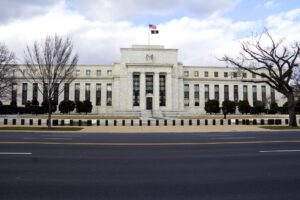
The Federal Reserve kept its key interest rate unchanged at Wednesday’s meeting, but signaled that three rate cuts are still expected in 2024. That leaves the Fed’s benchmark rate at a 23-year high of 5.25% to 5.5% for the fifth meeting in a row.
Deciphering the Fed’s “dot plot.”
The Fed released its latest rate cut projections, a chart known as the “dot plot.” Officials kept their forecasts in place signaling that they expect to lower the federal funds rates three times during 2024, dropping it to 4.5% to 4.75% by year’s end.
Markets react.
In the minutes immediately after the Fed meeting announcement stocks fell, gold surged higher, Treasury yields climbed, and the U.S. dollar headed south. Spot gold traded at $2,171.40 in afternoon action following the announcement.
Fed’s battle with inflation isn’t over yet.
While inflation has fallen from its 2022 high at 9.1%, recent date reveals that price increases are sticky and hard to eradicate. The latest consumer price index (CPI) data dashed hopes that the Fed had gotten price increases under control.
The February core CPI posted a hotter-than-expected reading, up 3.8% annually. The rising prices of rent, auto insurance, car repairs and airline tickets contributed to the stronger-than-expected inflation reading. Prices for used cars and clothing also climbed last month.
Inflation is still above the Fed’s stated 2% target.
At Wednesday’s Fed meeting, the central bank increased its 2024 core PCE inflation forecast to 2.6%, up from 2.4%. “Inflation has eased over the last year but remains elevated,” the Fed’s statement said. “The Committee remains highly attentive to risks.”
Gold in the midst of historic run higher.
Earlier this month, gold soared to a new all-time record high as voracious buying from Chinese investors, central banks and safe-haven investor buying keep the uptrend in the precious metal intact.
Gold has served as an asset to protect and preserve wealth for 5,000 year and investors today continue to pile into this asset, which has no counterparty or government risk.
Diversification is a prudent strategy, and those investing in gold have benefited handsomely, as gold has climbed 30% over the last 16 months. Looking ahead, Wall Street still expects more gold gains. With gold price forecasts at $2,300 and even $3,000 in the months ahead, investing in gold now could lock in significant price gains for you. Do you own enough gold? Don’t get left out during this historic gold run.
Want to read more? Subscribe to the Blanchard Newsletter and get our tales from the vault, our favorite stories from around the world, and the latest tangible assets news delivered to your inbox weekly.
1884 Indian Head Penny: A Tangible Piece of Early American History
Posted onDuring the economic chaos of the Civil War, Americans hoarded any precious metal they could find. Even copper-nickel one-cent pieces virtually disappeared from circulation. The U.S. government came to the rescue with the Act of April 22 and authorized a new thin, bronze version of the Indian Head penny.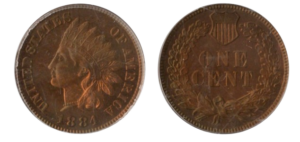
Indian Head pennies are an iconic, classic early American coin coveted by collectors. Minted from 1859 through 1909, Indian Head cents surged in popularity in the post-war era and were produced in large numbers in most years.
The exception is 1877 when a weak American economy decreased demand for new coinage, and only 852,500 Indian Head cents were minted, making it one of the rarest dates in the series. However, as coin operated machines became popular in the late 19th and early 20th centuries, the need for even more for Indian head pennies jumped and production topped 100 million in 1907.
Curious about this stunning early American coin? Blanchard has one 1884 Indian Head cent proof on offer. See it here. The 1884 Indian Head cent proofs had a tiny mintage totaling 3,942. Survivors are extremely scarce and hard to find. Like most Indian Head pennies, this proof coin from 1884 has seen its value climb in recent years, due primarily to the innate scarcity for a coin minted 140 years ago.
James Barton Longacre the Chief Engraver at the Philadelphia Mint designed this arresting early American coin, minted in Philadelphia. Longacre made his case for the new design featuring Lady Liberty in a traditional Native American headdress in a passionate letter to the director of the U.S. Mint James Snowden:
“From the copper shores of Lake Superior, to the silver mountains of Potosi from the Ojibwa to the Aramanian, the feathered tiara is as characteristic of the primitive races of our hemisphere, as the turban is of the Asiatic. Nor is there anything in its decorative character, repulsive to the association of Liberty … It is more appropriate than the Phrygian cap, the emblem rather of the emancipated slave, than of the independent freeman, of those who are able to say “we were never in bondage to any man”. I regard then this emblem of America as a proper and well defined portion of our national inheritance; and having now the opportunity of consecrating it as a memorial of Liberty, ‘our Liberty’, American Liberty; why not use it? One more graceful can scarcely be devised. We have only to determine that it shall be appropriate, and all the world outside of us cannot wrest it from us.”
The Indian Head penny features Lady Liberty on the obverse wearing a traditional Native American headdress. The design generated controversy as it appears that Lady Liberty is a Caucasian woman wearing a Native American headdress. In fact, legends claim the model for the coin is actually James Longacre’s daughter, Sarah! The handsome coin’s reverse features a lovely oak wreath with arrows at bottom and a shield at top.
1884 was an exciting time in American history. Imagine the stories this 140-year old Indian Head penny could tell!
In that year, a proclamation for the eight-hour workday in the United States was demanded by the Federation of Organized Trades and Labor Unions. In May 1884, Alaska became a U.S. territory. In July of that year, Dow Jones published its first stock market index: The Dow Jones Transportation Average, which is the oldest stock index still in use today.
In August, the cornerstone for the Statue of Liberty was laid on Bedloe’s Island in New York Harbor. In November, Democratic Governor of New York Grover Cleveland beat Republican James G. Blaine in a very close presidential election contest. In December, the Washington Monument was completed in Washington, D.C., which was the tallest structure in the world at that time.
Last but not least, in December, Mark Twain’s classic Adventures of Huckleberry Finn was first published in 1884.
In 1909, the Indian Head cent was replaced by the Lincoln cent, designed by Victor D. Brenner, closing an important era in U.S. numismatic history.
Want to read more? Subscribe to the Blanchard Newsletter and get our tales from the vault, our favorite stories from around the world and the latest tangible assets news delivered to your inbox weekly.
Carson City Morgan Dollars: A Favorite for Collectors across the Country
Posted onFor many numismatists, a Morgan silver dollar set is a must-have for their collection—and this is one of the most collected series of coins the U.S. Mint has ever produced.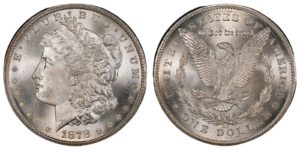
Within that series, the Morgan silver dollars minted at the legendary Carson City Mint in Nevada are highly sought after. And, there are only 13 coins in the Carson City Morgan dollar series. The exciting news? Building a Carson City Morgan dollar set is an attainable goal for most collectors.
History behind the Carson City Mint
Why are Morgan dollars with the famed “CC” mint mark so desirable? This storied western mint was in operation for a mere 21 years of remarkable Wild West history. Here’s how it all began…
In 1857, a miner named Henry Comstock laid claim to what became known as the Comstock Lode in Nevada. Prospectors struck it rich and earned massive fortunes. Word of the silver discovery spread quickly.
Nearby Carson City, Nevada grew fast as silver soon flowed out of the mine. The town was founded in 1858 and named after the iconic frontiersman: Kit Carson, a trapper, scout and guide. As more and more people flooded to the region, the need for coinage in everyday commerce skyrocketed. Demand for a second Mint in the West was strong.
At that time, Nevada was fairly isolated from the rest of the nation. And transporting raw precious metal to the San Francisco Mint was challenging. Railroads had not yet expanded to Nevada, which meant the only way to deliver gold and silver to San Francisco for processing was on horseback or a mule train. For many, that was a dangerous proposition in the rough and tumble Wild West, due to bandits and robbers on the open road.
So, only six years after Nevada became a state, the historic Carson City Mint began operations in 1870 order to process the huge amount of metal being mined in the area into sorely needed coinage.
Carson City Morgan Dollars
The Carson City Mint began producing Morgan dollars in 1878 and struck the silver dollars each year until 1885. Then, after a three year break, the Carson City Mint restarted production in 1889 and continued producing these coins until the Mint branch closed in 1893. There are a total of 13 issues highlighting the iconic “CC” Mintmark.
We list the Carson City Morgan Dollars below with their mintages.
Description Mintage
1878-CC 2,212,000
1879-CC 756,000
1880-CC 495,000
1881-CC 296,000
1882-CC 1,133,000
1883-CC 1,204,000
1884-CC 1,136,000
1885-CC 228,000
1889-CC 350,000
1890-CC 2,309,041
1891-CC 1,618,000
1892-CC 1,352,000
1893-CC 677,000
Generally speaking, Carson City Morgans were struck at low volumes. In total, the Carson City Mint produced only 13.7 million Morgan silver dollars.
To understand how truly low that number is, compare it to the amount of Morgans struck at the Denver Mint in 1921 alone – a whopping 20.3 million—in just one year!
If you want to build a Carson City Morgan dollar set, it’s worth knowing that the key date is the 1889-CC. The rarity of this coin stems from its incredibly low survivorship rather than its mintage.
Two other issues stand out in terms of mintage: the 1881-CC and 1885-CC, with low mintages of only 296,000 and 228,000 coins, respectively, which are the two lowest struck from Carson City.
The GSA Hoard
For collectors today, it is still possible to locate these coins as a large percentage survived in uncirculated condition through the “GSA Hoard.”
In case you aren’t familiar with this event, during the 1960s, the U.S. Treasury discovered bags of over 2.8 million Morgan Dollars, over 95% of which were minted at Carson City! In 1970, Congress directed the Treasury to transfer the coins to the General Services Administration in order to publicly sell the coins.
The GSA packaged the Carson City Morgan dollars in hard cover holders that said, “CARSON CITY UNCIRCULATED SILVER DOLLAR.” Each coin was sold with a certificate of authenticity that stated:
“This historic coin is a valuable memento of an era in American history when pioneers were challenging the West. The silver in this dollar was mined from the rich Comstock Lode, discovered in the mountains near Carson City, Nevada.”
Today, the surviving examples from the GSA Hoard that are still in their original hard cases are considered the most desirable of all.
George T. Morgan Designed the Beloved Silver Dollar
It’s easy to see why the Morgan dollar is beloved among numismatists. The large, nearly palm-sized heavy silver dollar is a joy to hold in your hand. George T. Morgan, an engraver at the Mint, designed the silver dollar.
The Carson City Morgan dollar features Lady Liberty’s head on the obverse. The reverse displays a stunning eagle. Morgan chose to depict Liberty as an American woman, rather than the typical Greek-style figures, and he used nature studies of the bald eagle to inspire him with his eagle design.
Carson City Morgan silver dollars represent a tantalizing combination of rarity and exciting Wild West history. Are you interested in building a Carson City Morgan silver dollar set? Even if you don’t see coins available for sale on our site, Blanchard has deep reach and connections within the numismatic community and are often able to source even hard to find coins. Give us a call and get started today!
Want to read more? Subscribe to the Blanchard Newsletter and get our tales from the vault, our favorite stories from around the world and the latest tangible assets news delivered to your inbox weekly.
Top-5 Discoveries from the SS Gairsoppa: Silver Bars, Coins and More
Posted onThroughout history, hidden gems often emerge in the aftermath of significant historical events. A prime example lies in shipwrecks, like the SS Gairsoppa. This ill-fated vessel became a testament to an intriguing chapter for coin and history enthusiasts alike. Investigating the findings following the ship’s sinking, this article explores the iconic SS Gairsoppa silver coins and bars born from the discoveries made, focusing on:
- The SS Gairsoppa’s dramatic history.
- A comprehensive catalog of the ship’s silver findings.
- Where to source salvaged SS Gairsoppa silver.
Watch this incredible video for an in-depth look into the Gairsoppa wreck:

https://www.youtube.com/watch?v=g4vV9I21ib4
A brief history of the S S Gairsoppa shipwreck
The SS Gairsoppa was a British cargo steamship. Commissioned in 1919, it was initially operated by the British India Steam Navigation Company. Its construction, with a gross tonnage of approximately 5,237 tons, reflected the maritime standards of its era. The vessel, with a sleek length of 412 feet and a substantial breadth of 53 feet, embodied both elegance and functionality.
The Gairsoppa began its maritime journey serving as a merchant vessel. For over two decades, it traversed the seas, transporting cargo and passengers between ports, significantly contributing to the global commerce of its time.
As the clouds of World War II gathered, the Gairsoppa found itself conscripted into service under the British Ministry of War Transport. Its role evolved from that of a commercial vessel to a vital cog in the war effort, tasked with transporting essential supplies, including iron ore, from India to Britain.
In February 1941, the SS Gairsoppa set sail from Calcutta, India, as part of a convoy bound for Liverpool, England. Sailing as part of a group of vessels, navigating together for mutual protection, was a common wartime practice to ensure safe passage across the treacherous North Atlantic.
However, misfortune struck when adverse weather conditions forced the Gairsoppa to veer off course, inadvertently separating it from the convoy’s protective shield. Alone and vulnerable, the vessel fell victim to a German U-boat lurking beneath the turbulent waves, the U-101, commanded by Captain Ernst Mengersen. A torpedo fired by the U-boat found its mark, and the Gairsoppa succumbed to the icy depths of the Atlantic, approximately 300 miles southwest of Ireland.
The sinking claimed the lives of the majority of the crew, with only one survivor, Second Officer Richard Ayres, managing to endure the harsh conditions of the open sea and reach the Irish coast after days adrift on a lifeboat. Despite Ayres’ survival, the fate of the Gairsoppa remained shrouded in mystery for decades, lost in the vast expanse of the ocean. It wasn’t until the early 21st century that the ship’s story experienced a resurgence, sparking renewed interest and exploration, particularly in the realm of Gairsoppa salvage, as the wreckage was discovered and efforts were made to recover valuable cargo from the ocean depths.
In 2010, a team led by the American exploration company Odyssey Marine Exploration located the wreckage of the Gairsoppa at a depth of nearly 15,000 feet. The discovery reignited interest in the ship’s history, shedding light on the circumstances surrounding its demise and the valuable cargo it carried, namely an estimated 7 million ounces of SS Gairsoppa shipwreck silver. This revelation sparked a salvage operation, marking one of the deepest and most challenging recovery efforts in maritime history.
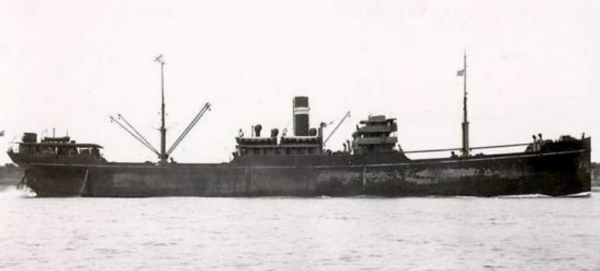
Photo Courtesy of Library of Contemporary History, Stuttgart
Gairsoppa silver recovery
The recovery of the SS Gairsoppa’s silver from the ocean bottom was a formidable undertaking that required cutting-edge technology and meticulous planning. The first step in the recovery process involved the utilization of remotely operated vehicles (ROVs) equipped with advanced sonar and imaging technology. These ROVs descended to the ocean floor, providing a detailed survey of the wreckage site. This crucial step allowed the salvage team to assess the condition of the ship and the distribution of the cargo, particularly the S.S. Gairsoppa shipwreck silver that held historical and monetary significance.
Upon completion of the survey, the salvage team employed specialized robotic arms attached to the ROVs for the delicate task of lifting the silver from the ocean bottom. The challenging underwater conditions, marked by extreme pressure and darkness, necessitated precision and expertise in maneuvering the robotic arms to handle the valuable metal.
To ensure the safe recovery of the vessel’s silver cargo, Odyssey Marine Exploration implemented state-of-the-art techniques for retrieval. The use of specialized equipment, such as specially designed baskets and containers, facilitated the careful lifting of the precious metal from the ocean floor. These containers were then secured to the ROVs and slowly hoisted to the surface, minimizing the risk of damage to the valuable cargo during ascent.
The recovered silver, totaling millions of ounces, marked a historic achievement in maritime salvage. Found in the form of large ingots rather than Gairsoppa coins, these substantial pieces of silver added to the complexity of the salvage operation. The Gairsoppa silver’s extraction from the ocean depths not only brought closure to the story of the iconic vessel but also showcased the capabilities of modern underwater exploration and recovery technology.
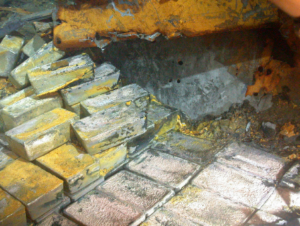
Photo by Postal Museum
SS Gairsoppa silver bar findings
The silver recovered from the Gairsoppa shipwreck took the form of large ingots. More specifically, a total of 2,792 silver bars, each containing nearly 1,100 ounces of .999 pure silver, were salvaged. Today, collectors and silver investors keen on possessing a tangible piece of maritime history can acquire the following SS Gairsoppa silver bars.
1. Original SS Gairsoppa 1000 oz bar
Remarkably, contemporary silver collectors have the unique opportunity to acquire original ingots salvaged from the SS Gairsoppa, forging a tangible link to the wartime era. Among the 2,792 silver ingots recovered by Odyssey Marine Exploration, a select 462 were made available to the public, transforming them into authentic and coveted rarities.
Minted at His Majesty’s Mint in Bombay, each original Gairsoppa silver bar is distinguished by a unique serial number and the official stamp “HM Mint Bombay,” echoing the craftsmanship of a bygone era. While the ingots do not feature a date on them, their estimated production date falls between 1829 and 1919, i.e. the dates of the HM Mint Bombay’s operation.
A particularly intriguing facet of these large bars is the discrepancy in their marked and actual weight. Although stamped as 1,041.1 ounces, the average “SS Gairsoppa silver ingot 1000 oz” has a slightly lesser recovered weight, resulting from the impact of corrosion during the silver bars’ prolonged submersion in the ocean. This natural consequence, common in shipwreck recoveries, contributes to their deeply toned condition, enhancing their authentic charm. Collectors appreciate this nuanced history, reinforcing the allure of these Gairsoppa ingots as genuine artifacts from a significant maritime chapter.
S.S. Gairsoppa Shipwreck 1,036.6 Ounce Ingot
- Metal: Silver
- Year: Between 1829 – 1919
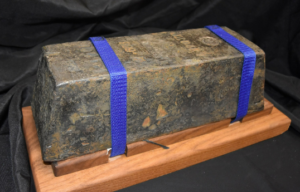
Photo by Great Collections
2. 10 oz Gairsoppa silver bar
Crafted as a tribute to the significance of the historic vessel, commemorative SS Gairsoppa 10 oz silver bars were made from the remaining 2,330 ingots that were not distributed to the public, offering a unique and affordable silver investment opportunity.
Meticulously produced by Sunshine Minting, a reputable private mint, each of these bars encapsulates approximately 10 ounces of .999 pure silver and bears distinctive markings attesting to its special origin. On one side, the “Gairsoppa silver bar 10 oz” features an intricate engraving of the SS Gairsoppa along the date of the shipwreck. On the other, it bears a detailed stamp indicating its weight and certification as recovered GAIRSOPPA silver. Combining a unique fusion of historical context, craftsmanship and intrinsic value, these bars constitute a prized addition to any collector’s portfolio.
10 oz. S.S. Gairsoppa Commemorative Bar
- Metal: Silver
- Year: 2013
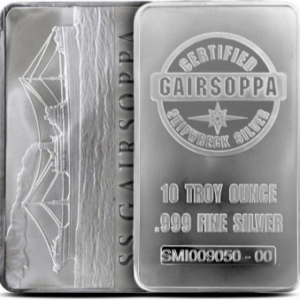
To explore a broader array of silver options, beyond the offerings of Gairsoppa silver bars for sale, browse Blanchard’s extensive silver selection here.
SS Gairsoppa silver coin commemoratives
Unlike other famous shipwrecks, the Gairsoppa ship yielded no coins in its recovered cargo. However, following its legendary salvage operation, commemorative coins were produced to honor the historic vessel. These numismatic treasures stand as enduring tributes to the SS Gairsoppa’s unique legacy and are cherished by collectors looking for SS Gairsoppa shipwreck silver for sale.
1. 2013 50p Britannia – SS Gairsoppa silver coin
Shortly after Odyssey Marine Exploration’s salvage operation, the Royal Mint decided to issue commemorative SS Gairsoppa coins. The 2013 50p Britannia is a limited edition coin crafted with precision, featuring a quarter-ounce of pure .999 silver recovered from the sunken vessel. Its iconic obverse design by Philip Nathan showcases Britannia standing proudly with a shield, symbolizing the resilience of the British spirit. On the reverse, Ian Rank Broadley’s portrait of Her Majesty Queen Elizabeth II graces the coin.
Weighing 7.86 grams and measuring 22.00 mm in diameter, this SS Gairsoppa Royal Mint bullion coin bears a unique inscription, “S.S. Gairsoppa,” on its rim, paying homage to the ship and its crew. Limited in mintage and finished to the Royal Mint’s exacting standards, it serves as a tangible connection to the maritime history of the SS Gairsoppa, making it a prized addition to numismatic collections worldwide.
2013 50p Britannia – SS Gairsoppa
- Metal: Silver
- Year: 2013

Photo by PCGS
2. 2014 50p Britannia – SS Gairsoppa coin
Following the success of the 2013 Britannia 50p Gairsoppa coin, the Royal Mint continued this numismatic tribute in 2014. This limited edition coin, also weighing one quarter of an ounce of pure .999 silver recovered from the Gairsoppa shipwreck, features the iconic design of Britannia by Philip Nathan and Ian Rank Broadley’s portrait of Queen Elizabeth II as well.
When paired with the preceding year’s coin, Gairsoppa coins for sale offer collectors a compelling narrative of historical significance and artistic elegance, enhancing the completeness of a numismatic collection.
2014 50p Britannia – SS Gairsoppa
- Metal: Silver
- Year: 2014
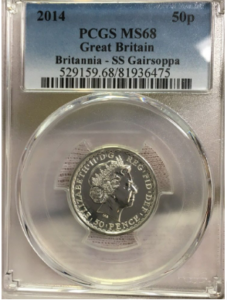
Photo by PCGS
3. 1 oz S.S. Gairsoppa shipwreck silver round
First manufactured in 2014 by the Sunshine Mint in the United States, the Gairsoppa 1 oz silver round was also struck from silver salvaged from the Gairsoppa. A strikingly beautiful piece, it features a unique obverse design of the iconic ship cruising on calm waters, with a bright silver finish accentuating the scene and contrasting darker areas adding depth. Its reverse displays inscriptions for weight and purity, including “Certified Shipwreck Silver” around the central “Gairsoppa”, making it a prized collector’s item for those seeking an authentic Gairsoppa shipwreck silver round.
1 oz. S.S. Gairsoppa Shipwreck Round
- Metal: Silver
- Year: 2014

Photo by Canadian Coin Blog
Where to buy historically valuable silver coins and bars
The storied legacy of the S.S. Gairsoppa and the precious silver recovered from its depths offer not just historical value but a tangible investment in the enduring value of precious metals. To embark on this journey of acquiring a piece of SS Gairsoppa silver bars for sale, consider using Blanchard. The company’s unparalleled expertise, commitment to customer satisfaction, and comprehensive guidance make Blanchard a trusted and outstanding choice for navigating the intricate world of precious metals and rare coins. Contact Blanchard’s team of experts to explore the world of Gairsoppa shipwreck silver and other historic silver, where every piece tells a captivating tale and holds the potential for lasting investment value.
Want to read more? Subscribe to the Blanchard Newsletter and get our tales from the vault, our favorite stories from around the world and the latest tangible assets news delivered to your inbox weekly.
The Connection between Risk Tolerance and Gold
Posted onOne of the most important questions for any investor is how much risk are you comfortable with? In investing, risk can be defined as:

- The permanent loss of your money or
- Not having money when you need it.
Both outcomes are undesirable to say the least.
Stocks are considered one of the most risky asset classes. Stocks tend to be more volatile than bonds and can deliver a higher expected return. But in exchange, stock investors take on a greater risk of loss. So, if you have 80% of your portfolio invested in stocks that is considered to be a fairly aggressive or highly risky level.
Risk tolerance measures how much risk you are willing to take on. To consider your own risk tolerance level ask yourself these questions:
- What are your investing goals?
- How soon will you need your money?
- How comfortable are you with losses?
Considering your feelings around portfolio losses is an important consideration. There have been 28 bear markets since 1928, with an average stock market decline of 36%.
However, some bear markets in stocks have been much worse—for example, the 2008 financial crisis saw a 51.93% decline in the stock market. That means if you had a one million dollar portfolio you’d have lost roughly half of your total investments. You’d have watched your million dollar portfolio sink down to $500,000 during the 2008 stock market crash.
While you can’t control the stock market, you can mitigate some of your risk with an allocation to gold.
Gold serves investors well on three key fronts. Gold provides risk management, capital appreciation and wealth preservation. Indeed, gold doesn’t just diversify your portfolio and protect your wealth—it can also help you grow your wealth. Over the past twenty years, gold has returned an average of 8.34% annually.
How much gold should you own? This depends on your risk tolerance level, your investing goals and your time horizon. But, research shows that holding between 2% and 10% of your total portfolio in gold improves portfolio performance (better returns) and reduces total portfolio losses (lower drawdowns) compared to a portfolio that doesn’t hold any gold.
Best Returns for Portfolios with 10% Allocation to Gold
Portfolios containing a 10% allocation to gold saw the largest annualized and cumulative returns, with the lowest maximum drawdown, according to State Street Global Advisors.
Today, amid warnings of an overvalued and frothy stock market, it’s worth considering if you have enough wealth protection right now. If not, the research shows that adding more gold to your portfolio is a proven solution and can help you take some of the investing risk off the table.
Want to read more? Subscribe to the Blanchard Newsletter and get our tales from the vault, our favorite stories from around the world and the latest tangible assets news delivered to your inbox weekly.
Could Gold Hit $3,000? Citi Analysts Say It’s Possible in 2025
Posted onGold at $3,000 an ounce? From current levels, that would mark a nearly 50% increase in price. While it’s not their base case, the global banking giant—Citi—highlighted economic scenarios which would support a massive increase in the price of gold to $3,000 in 2025.
So what could push price gold to $3,000? Aggressive central bank purchases, stagflation, and a global recession are all triggers that could drive the price of the yellow metal to $3,000 an ounce, Aakash Doshi, Citi’s North America head of commodities research, told CNBC. What are the dynamics around these three potential triggers? Let’s explore.
Central bank purchases
It’s no secret that central banks have been on a gold buying spree, with gold purchases hitting record levels in the last two years.
Why are they buying? For central banks, gold is increasingly being considered an alternative to fiat reserve currencies like the U.S. dollar, euro, and Japanese yen—and central banks are stocking up. They also see gold as a way to diversify geopolitical risk and ensure access to liquidity without credit risk.
In the first nine months of 2023, central banks bought an astonishing net 800 tonnes of gold, 14% higher than the same period last year, according to the World Gold Council.
Citi weighs in on what how that trend could support gold prices ahead: “The most likely wildcard path to $3,000/oz. gold is a rapid acceleration of an existing but slow-moving trend: de-dollarization across Emerging Markets central banks that in turn leads to a crisis of confidence in the U.S. dollar,” Citi analysts wrote in a recent note.
Stagflation
Citi’s Doshi called a stagflation scenario a “low probability”— nonetheless, gold would benefit if this were to unfold.
What is stagflation? It’s a mix of high inflation and slow economic growth. The U.S. experienced this—painfully—in the 1970’s. It’s interesting to look at how gold performed in that period.
- Between 1973 and 1979, gold produced an astonishing 35% annual return.
- In six of the last eight recessions, gold outperformed the S&P 500 by 37% on average.
These numbers demonstrate the extraordinary diversification power that gold can generate for your portfolio—especially in uncertain macroeconomic times.
Global recession
Last but not least, the last trigger that could send gold to $3,000 according to Citi is a global recession. This scenario also seen as “low probability” would force the Federal Reserve to cut interest rates quickly to help support economic growth. Typically, gold reveals an inverse relationship with interest rates, meaning as interest rates fall—gold climbs. A rapid cut in rates would be very beneficial to gold.
The bottom line
While these scenarios may or may not come to pass, what is certain is that gold continues to provide investor’s a bedrock of safety. Gold is a safe haven and performs well during economic uncertainty, stock market declines, recessions and financial crises. Gold is a dependable insurance policy for your wealth. Do you own enough to protect and grow your wealth in the months and years ahead? Even if these three scenarios don’t come to pass, Citi still forecasts a new record high for gold by the end of 2024. That will make today’s gold prices seem like a bargain.
Want to read more? Subscribe to the Blanchard Newsletter and get our tales from the vault, our favorite stories from around the world, and the latest tangible assets news delivered to your inbox weekly.
The 1893 Queen Isabella Quarter: First U.S. Coin to Feature a Real Woman
Posted onThe 1893 Queen Isabella quarter boasts a lot of “firsts” attached to its name.
The silver commemorative coin was the first U.S. coin to feature a real woman, as opposed to the mythical Lady Liberty. The silver quarter features Queen Isabella of Spain – to honor her role in supporting Christopher Columbus’ voyage to the Americas in 1492.
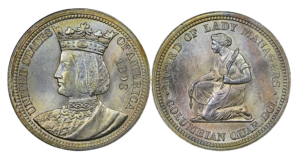
The 1893 Queen Isabella quarter is also the first legal tender U.S. coin to feature a foreign monarch. Last but not least, it is also the first and only U.S. commemorative quarter dollar not intended for circulation.
The 1893 Queen Isabella quarter was minted for the World’s Columbian Exposition, which celebrated the 400th anniversary of Columbus’ journey to America. However, Queen Isabella wasn’t the only woman that is remembered today in relation to this beautiful and rare coin. The story behind the coin’s creation adds an aura of intrigue and excitement to this silver coin with a tiny mintage at 24,214.
During this period in American history, the woman’s suffrage movement was beginning to gain steam, even though it wasn’t until 1920 when the right for women to vote was granted nationally. Perhaps in a nod to that movement, the U.S. Congress authorized the formation of a “Board of Lady Managers” to help plan the 1893 World Columbian Exposition, also known as Chicago’s World Fair.
Bertha Palmer, a Chicago socialite and wife of prominent local businessman Potter Palmer, owner of the legendary Chicago Palmer House hotel was named President of the Board of Lady Managers.
Palmer worked tirelessly to help the Chicago Fair become a major success. And, it was under Palmer’s leadership and suggestion that the U.S. mint a commemorative coin with a woman on it, specifically Queen Isabella.
The Board of Lady Managers took complete charge of the quarter-dollar project and decided that the coins would feature a female motif. A depiction of Queen Isabella of Spain was chosen since it was King Ferdinand and Queen Isabella who provided the financing for Columbus’ journey to the Americas, with Isabella reportedly offering her crown and jewels if necessary to help pay for the expedition. Production of the Isabella quarter dollars began at the Philadelphia Mint on June 13, 1893.
At the Chicago Fair, sales of the Isabella quarter didn’t see huge demand. A key reason was that fair goers saw better value in the Columbian half dollar. Both the half dollar and quarter were sold for $1. Buyers preferred to go home with a 50 cent coin for their dollar instead of quarter worth 25 cents back then. It was said that Mrs. Potter herself bought as many as 10,000 of the Isabella quarters in an attempt to boost sales.
Isabella quarters were never released into circulation. And, nearly 16,000 Isabella quarters were sent back to the U.S Mint and melted down.
Despite the rocky sales at the World Fair, today, Isabellas are highly desired and strong collector demand is seen for this coin with many “firsts” and a unique back story. Collectors seek to acquire the 1893 Isabella quarter as a part of commemorative series and also seek to acquire this coin as a “type” quarter.
Want to read more? Subscribe to the Blanchard Newsletter and get our tales from the vault, our favorite stories from around the world, and the latest tangible assets news delivered to your inbox weekly.
5 Most Controversial Rare Coins from the US Mint
Posted on- Type 1 Standing Liberty Quarter
- 1909-S VDB Cent
- 1964-D Peace Dollar
- 1946 Roosevelt Dime
- $1,000,000,000,000 Platinum Coin
From illegal to immoral to outrageous, it turns out there’s plenty of ways for a U.S. rare coin to be controversial. Today, we explore five of the most controversial coins produced by the U.S. Mint, many of which are highly coveted by collectors in large part due to their controversy!
1. Type 1 Standing Liberty Quarter
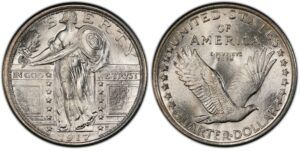
The classic Type 1 Standing Liberty Quarter was minted in 1916 and 1917 featuring one of the most elaborate designs on any U.S. coin. Sculptor Hermon MacNeil designed this coin depicted Lady Liberty standing between to pedestals wearing a flowing gown.
The controversy? Lady Liberty’s right breast was not covered. There was an immediate public outcry over public nudity when these coins were released into circulation! The Society for the Suppression of Vice began a campaign urging the U.S. government to halt production of the coin they called “immoral” and also asked for a recall for the coins already in circulation.
The U.S. mint produced and released into circulation 55,230,000 coins before production of the Type I design was halted. In 1917, without input from MacNeil, the Liberty Quarter was restruck with a covering over her upper torso that resembled chain mail—returning dignity to Lady Liberty.
The Type 1 Standing Liberty Quarter is an early classic, highly collectable and demands a large premium over the Type II Standing Liberty quarters.
2. 1909 VDB Cent
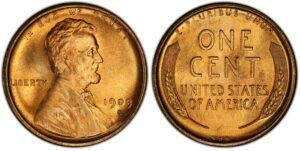
Throughout history only a few men rose to such prominence to be instantly recognized by their initials. There’s a few: like FDR, JFK and LBJ. However, within the numismatic world, expert collectors instantly recognize the initials VDB.
Who is VDB you may wonder? Born Viktoras Barnauskas on June 12, 1871 in Shavli, Lithuania, Brenner immigrated to America arriving in 1890. Eventually, Brenner became a New York City jewelry engraver. However, his true passion was medals, sculpting and numismatics.
In 1908, President Roosevelt wanted a new coin to honor the 100th anniversary of Abraham Lincoln’s birth. Roosevelt explored the idea of featuring an image of Lincoln on the coin as he considered and ultimately accepted the proposal submitted by Victor David Brenner.
The public eagerly anticipated the release of the new Lincoln cent in 1909 as this was the first ever regular issue coin in American history to feature a real person! On August 2, 1909, the police were called in to keep the crowds in order, as the coin was distributed for the first time at a Treasury building on Wall Street.
Within a few short days, controversy and scandal broke out over Brenner’s initials V.D.B on the reverse. Public outcry and complaints emerged over the size and placement of the initials.
As the controversy swirled, only a few days after production began, Treasury Secretary Franklin MacVeagh sent a message: Stop the mints! He halted production of the coin and ordered the initials removed. In that short time, however, almost 28 million cents were struck in Philadelphia and 484,000 at the San Francisco Mint.
The Lincoln cent was the only coin ever designed by Brenner, but his tribute lives on as one of the most popular and widely used coins in American history.
3. 1964-D Peace Dollar

U.S. Mint records state that 316,076 silver Peace dollars were struck at the Denver Mint in May of 1965 (though they were backdated to 1964).
At the time, a massive silver shortage made these Peace dollars significantly more valuable for their silver content than their $1 face value. Indeed before these coins were even released to the public, private collectors were advertising offers of $7.50 each to buy the coins. Amid concerns of public hoarding, the silver Peace dollar program was cancelled and the coins were condemned to the melting pot. The 1964 Peace Dollars were never released to the public.
And, notably, today, it is illegal to possess a 1964-dated Peace dollar.
So do any still exist today? According the official story, at the time, all but two of the 1964 Peace Dollars were melted down for their silver content. The two survivors were reportedly sent to Washington, D.C., where they remained until 1970 when Mint records say they too were melted in the presence of a destruction committee.
Legend has it that there may be a survivors. There are rumors that every employee in the Denver Mint received two coins each, and it’s possible that Mint employees could have pocketed one without anyone looking. But even if a 1964 Peace Dollar were found today, it would be illegal to own since the coin was never officially monetized.
4. 1946 Roosevelt Dime
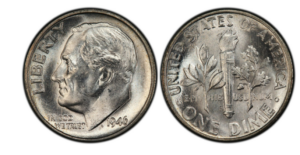
In 1946, the U.S. Treasury introduced the Roosevelt dime to honor the recently deceased president. At this point in history, the public mood of the nation was cautious. The Cold War was just beginning and Senator McCarthy had launched his anti-Communist movement.
On the dime’s design, below Roosevelt’s neck and to the left of the date a small JS is featured, the designer’s initials.
A conspiracy theory quickly spread across the nation like wildfire that accused U.S. Mint workers of being Communists, and the JS was a secret message to honor Soviet dictator Joseph Stalin. The Mint received a huge number of letters accusing them of promoting Communism with the release of the new dime. The rumors were so pervasive that the U.S. Mint had to issue a press release to dispel the controversy, but they kept the initials on the dime.
5. $1,000,000,000,000 Platinum Coin
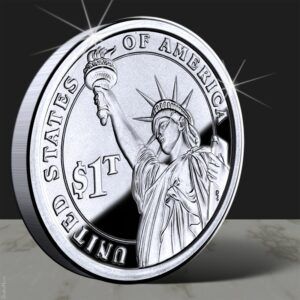
This last controversial coin has not yet been minted. It is a proposed trillion dollar platinum coin that has been bandied about at times as a solution to the various debt limit crisis that the U.S. government has faced. On numerous occasions in recent years, the U.S. government has come up against the deadline where it would run out of money to pay its bills. In 2001, Congress passed a law that allows the U.S. Treasury to mint platinum coins of any value without Congressional approval. According to that law, the U.S. Treasury could set the coin’s value at anything, they choose. But, the coin would need to be struck in platinum, not gold or silver, nickel, bronze or copper, which are under Congress’ control.
In theory, a U.S. President could order the Treasury Secretary mint a coin with the value of $1 trillion and then deposit it into the Treasury, giving the government an extra trillion dollars to cover debts and prevent default.
The proposal has resurfaced from time to time over the years as Congress has several times faced debt limit battles. However, the proposal has been called a “gimmick” and has been met with controversy over concerns it would debase “the full faith and credit” that is currently entrusted into our nation’s currency. But, could it be done? Technically it appears yes.
Want to read more? Subscribe to the Blanchard Newsletter and get our tales from the vault, our favorite stories from around the world and the latest tangible assets news delivered to your inbox weekly.
Is Inflation Over Yet? Nope, CPI Data Reveals Still Hotter Than Expected
Posted onWhen you are traveling on a road trip with kids, a question you often hear is: “Are we there yet?”
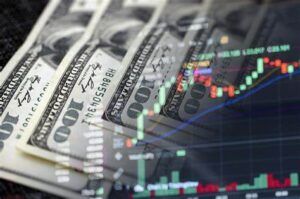
For Americans tired of the high prices they see every day from food at the grocery store to personal care products, pet food and haircuts, many are asking: “Is inflation over yet?”
The latest Consumer Price Index report shows what you probably already know – inflation is stubborn and still sticking around. Yep, kind of like that house guest who has overstayed their welcome.
In January, the CPI report showed that consumer prices rose 3.1% versus a year ago. That number came in higher-than-the-expected 2.9% reading economists had forecast. The stock market sank on the news with the Dow Jones Industrial Average down more than 500 points, or about 1.4%, its worst one-day decline since March. The hotter-than-expected inflation number triggered speculation that this could hold the Federal Reserve back from cutting interest rates soon.
So, what does this mean for you?
For now, the Fed has not vanquished inflation. Every day, Americans are seeing still-high stubbornly high food prices. It’s not your imagination. Since January 2020, supermarket prices have climbed 25%, while general consumer inflation has surged 19% over that time period. The latest CPI shows that it still costs more to fill up your shopping basket at the grocery store than it did last month.
You’ve seen it firsthand. That package of cookies or crackers is literally smaller than it was two years ago. You know the rub, you pay more, but get less. It’s called “shrinkflation.” The food companies aren’t tricking anyone with that move.
For the economy, this may mean that interest rates stay high for longer than expected, but the Fed is still expected to cut rates in 2024. For many Americans there is so much that feels out of their control. And, it’s true. We can’t control the rate of inflation, we can’t control where the stock market goes and we can’t control when the Fed will cut rates.
Fortunately, as investors, there are many things in your control. That includes how you diversify your portfolio, what assets classes you add savings to and even how you save for retirement. In the midst of the stubbornly high inflation and economic uncertainty, gold continues to shine as a proven safe-haven asset for investors.
Gold gained over 14% last year and is forecast to hit new record-high levels this year. Research consistently shows that adding up to 5% or more of your overall portfolio to gold helps improve your long-term returns by decreasing drawdowns (losses) and smoothing out the ups and downs during big stock market crashes. Throughout history, gold has served as a store of value and has kept pace or outpaced inflation over the years. Wondering what your next move should be? Explore the Top Five Gold Bullion Coins for Investors article and give Blanchard a call if you’d like personalized advice. We’re here to help.
Want to read more? Subscribe to the Blanchard Newsletter and get our tales from the vault, our favorite stories from around the world, and the latest tangible assets news delivered to your inbox weekly.







